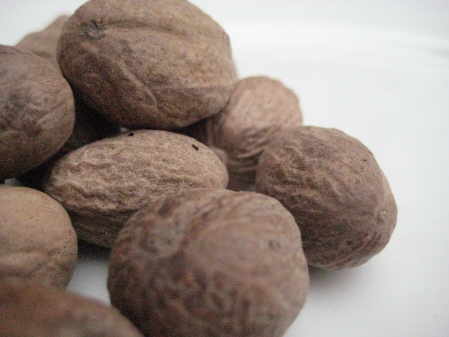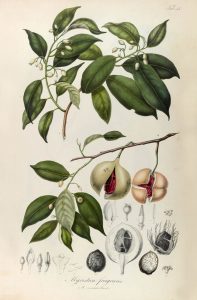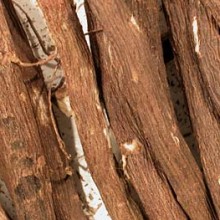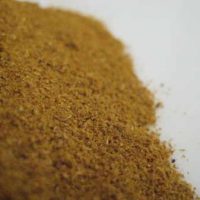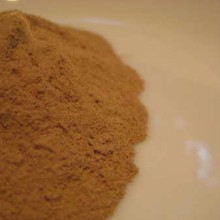The Nutmeg is a genus of evergreen trees indigenous to tropical southeast Asia and Australasia. They are important for two spices derived from the fruit, Nutmeg and Mace.
Nutmegs are the actual seed of the tree, roughly egg-shaped and about 20-30 mm long and 15-18 mm wide, and weighing between 5 and 10 grams dried, while Mace is the dried “lacy” reddish covering or arillus of the seed.
Several other commercial products are also produced from the trees, including essential oils, extracted oleoresins, and nutmeg butter.
The pericarp (fruit/pod) is used in Grenada to make a jam called Morne Delice. In Indonesia, the fruit is sliced finely, cooked and crystallised to make a fragrant candy called manisan pala (“nutmeg sweets”).
The most important species commercially is the Common or Fragrant whole Nutmeg (Myristica fragrans) native to the Banda Islands of Indonesia; it is also grown in the Caribbean, especially in Grenada. Other species include Papuan M. argentea from New Guinea, and Bombay M. malabarica from India; both are used as adulterants of M. fragrans products.
Culinary Uses for Nutmeg:-
Mace and Nutmeg have similar taste qualities, The latter having a slightly sweeter and Mace a more delicate flavour. Mace is often preferred in light-coloured dishes for the bright orange, saffron-like colour it imparts.
In Indian cuisine, Both spices are used almost exclusively in sweets. It is known as jaiphal in most parts of India. They are also used in small quantities in Garam Masala.
In other European cuisine, both spices are used especially in potato dishes and in processed meat products; they are also used in soups, sauces and baked goods.
Japanese varieties of curry powder include both spices as an ingredient.
Both spices are a traditional ingredient in mulled cider, mulled wine, and eggnog.
History:-
There is some evidence that Roman priests may have burned Nutmeg as a form of incense, although this is disputed. It is known to have been used as a prized and costly spice in the Middle Ages. Saint Theodore the Studite was famous for allowing his monks to sprinkle both spices on their pease pudding when required to eat it. In Elizabethan times it was believed that nutmegs and mace could ward off the plague, so they was very popular. They were traded by Arabs during the Middle Ages in the profitable Indian Ocean trade.
In the late 15th century, Portugal theoretically took over the Indian Ocean trade under the Treaty of Tordesillas with Spain and a separate treaty with the sultan of Ternate. But their control of this trade was always only partial and they remained largely participants, rather than overlords. The authority Ternate held over the spice-growing centre of the Banda Islands was quite limited, and the Portuguese failed to gain a serious foothold in the islands themselves. The trade in the spice later became dominated by the Dutch in the 17th century, who managed to establish control over the Banda Islands after an extended military campaign that culminated in the massacre or expulsion of most of the islands’ inhabitants in 1621. Thereafter, the Banda Islands were run as a series of plantation estates, with the Dutch mounting annual expeditions in local war-vessels to extirpate the trees planted elsewhere.
As a result of the British interregnum during the Napoleonic Wars, the English took temporary control of the Banda Islands from the Dutch and transplanted nutmeg trees to their own colonial holdings elsewhere, notably Zanzibar and Grenada.
Connecticut gets its nickname (“the Nutmeg State”, “Nutmegger”) from the legend that some unscrupulous Connecticut traders would whittle “nutmeg” out of wood, creating a “wooden nutmeg” (a term which came to mean any fraud)

